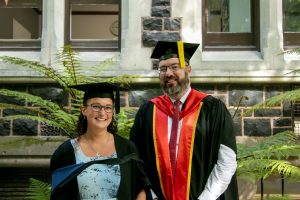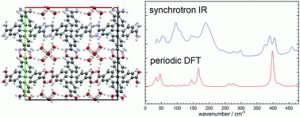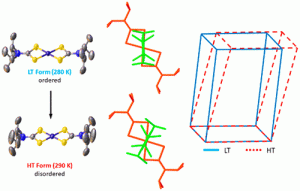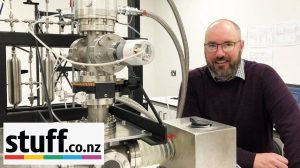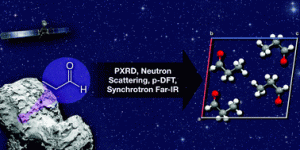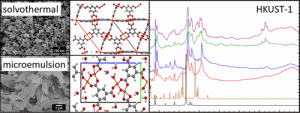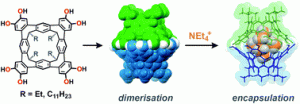Congratulations MSc Graduate Sam McIntyre
Congratulations to Sam McIntyre who graduated in December completing her MSc dissertation on the hydrogenation of NO on ice surfaces, co-supervised by Assoc. Prof. Anna Garden. A quantum calculation methods study supported by laboratory ice spectroscopy; look out for the results to be published soon. A job well done Sam!
Ennis Group ANSTO Co-crystal Experiments
Ennis group PhD students Larissa Lopes-Cavalcante and Tait Francis have just returned from Sydney after participating in the ANSTO-HZB Neutron School (where both were winners of the practical exercise prize) followed by a run of experiments on the ACNS Wombat and Echidna beamlines. Here the team, mentored by Helen Maynard-Casely, have investigated a series of Titan relevant molecules in the search for new co-crystal structures. Stay tuned for new highlights from the post-analysis!
Synchrotron Far-IR and DFT Study of HOF Materials
Just out in PCCP is our first collaboration with the White group (ANU) where we have combined synchrotron vibrational studies with periodic DFT to survey the channel surface topology and water-solvent binding interactions of a suite of HOF compounds; porous materials for potential molecular storage and separation technologies. Hopefully the first work of many!
Read here: Ennis, Appadoo, Boer & White (2022) PCCP.
Synchrotron Studies of Jumping Crystals
Appearing this week in ACS Crystal Growth & Design as an ASAP paper is the Ennis lab collaboration with Angeloski and coworkers at UTS where synchrotron XRD and THz spectroscopy has been used to characterise the onset of thermosalience (phase transition leading to a macroscopic “jump” via anisotropic lattice alteration) in a Ni(II) system. Check out some rather formidable periodic-DFT frequency calculations applied to assign far-infrared spectra.
Read more here: Angeloski et al. Crystal Growth & Design (2022)
Marsden Research Highlighted in Stuff News Feature
The Ennis lab Marsden Fund research project toward the synthesis of life-bearing organic molecules from co-crystals in Titan’s environment was featured in an article in Stuff News NZ; also touching on broader planetary chemistry and Courtney’s career path to Otago Chemistry. Check it out here:
Kiwi scientist looking for bits of life on Saturn’s moon Titan
Propanal Crystal Structure Now Solved
Just hitting the shelves in PCCP is our collaborative work with Helen Maynard-Casely at ANSTO and Sam Duyker at USyd where we have solved the solid structure of propanal ice absent from the literature. Based on Nick Yevstigneyev’s CHEM390 and Summer Scholarship project at Chemistry Otago, we now have data to look for this small astromolecule, and potential amino acid precursor, in planetary environments.
Read Here: Maynard-Casely, Yevstigneyev, Duyker & Ennis, PCCP, 2021
ODT feature on the Ennis lab
A short article and video of the Marsden Fund supported research project was featured in the Otago Daily Times this week. Please click to see Courtney at the controls of the astrochemistry surface experiment and discussing Dragonfly’s search for life’s molecular building blocks on Titan.
Marsden Success!!!
The Ennis group, in collaboration with Helen Maynard-Casely (ANSTO) and Morgan Cable and Robert Hodyss (NASA JPL), are extremely delighted to announce that our full Marsden Fund proposal – the investigation of co-crystal chemistry on Titan – has been funded 2022 through 2024. We will be very excited to advertise positions for a PhD and Postdoc on experimental astrochemistry studies at the University of Otago in the near future, where opportunities to travel and work alongside this fantastic group of AIs in their respective laboratories will form part of the project. We can’t wait to get started on this new international collaboration!
Please read more about our work here in the Marsden Fund press release:
Synchrotron Far-IR for MOF Morphology Changes
Appearing in the pages of the Journal of Physical Chemistry C this month is a collaboration between the Ennis and Meledandri workgroups interrogating the gas adsorption and thermal properties of Cu(II)BTC MOF nonparticles with synchrotron far-infrared and periodic DFT. Here we prevent peculiar, temperature dependent, structural changes between HKUST-1 polymorphs; revealed by low frequency lattice and torsional modes. Thanks to Subo Lee at Massey for some additional characterisation.
Read Here: Ennis, Tay, Falconer, Lee & Meledandri (2021) JPCC
Hydrogen-bonded cavitands for cation encapsulation
Just published in RSC Chemical Science is a report by Jordan Smith from the Lucas group on new cavitand dimers bound by hydrogen-bonding interactions. The Ennis group have contributed DFT calculations to determine binding energies for a range of neutral and cationic guest species to corroborate NMR titrations. Have a read!

